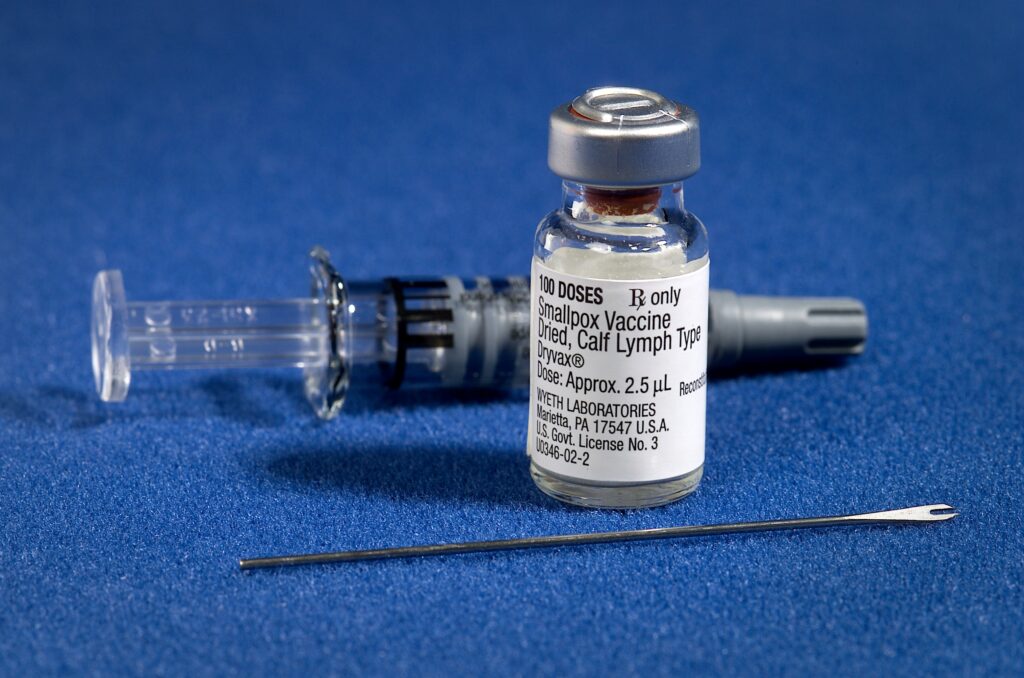Smallpox vaccination has played a pivotal role in one of the greatest achievements in medical history—the global eradication of smallpox. Although routine immunization ceased decades ago, the smallpox vaccine remains an essential part of global biosecurity strategy. This article provides a comprehensive overview of smallpox vaccination, including historical milestones, vaccine types, immunological mechanisms, current use in bioterror preparedness, and potential adverse effects.

The Origins of Smallpox Vaccination
Edward Jenner and the Invention of Vaccination
In 1796, Edward Jenner introduced the concept of vaccination by using cowpox (vaccinia virus) to protect against smallpox. His method revolutionized medicine and marked the beginning of modern immunization.
Global Implementation
By the mid-20th century, smallpox vaccination became a global priority. The World Health Organization (WHO) launched the Intensified Smallpox Eradication Program in 1967, which heavily relied on mass and ring vaccination techniques to interrupt transmission.
Vaccine Types: ACAM2000 and Jynneos
ACAM2000
- Live, replication-competent vaccinia virus
- Administered via scarification using a bifurcated needle
- Induces a visible “vaccine take” (pustule), confirming immunity
- Associated with more severe side effects, particularly in immunocompromised individuals
Jynneos (also known as MVA-BN or Imvamune/Imvanex)
- Non-replicating live vaccinia virus vaccine
- Administered subcutaneously in two doses
- Lower risk of side effects, approved for use in people with weakened immune systems
- Used in both smallpox and monkeypox prevention
Immunity and Immune Response
Mechanism of Protection
Vaccination with vaccinia virus triggers both:
- Cell-mediated immunity: Activation of T-cells against orthopoxviruses
- Humoral immunity: Generation of neutralizing antibodies
Protection is typically effective within 10 days post-vaccination, with post-exposure prophylaxis reducing disease severity if administered within 3–4 days.
Duration of Immunity
- Immunity may last decades, though protection wanes over time
- Historical evidence shows partial protection even 30+ years after vaccination
- Booster doses may be required for high-risk individuals
Vaccination Protocols in Modern Preparedness
Routine Use
- Discontinued in 1980 after eradication of smallpox
- Not recommended for the general public today
Current Indications
- Laboratory workers handling orthopoxviruses
- Military personnel and select government responders
- Post-exposure prophylaxis in the event of confirmed exposure
- Strategic use in bioterrorism response plans
Stockpiles and Emergency Use
- National stockpiles include both ACAM2000 and Jynneos
- WHO and CDC maintain global reserves for rapid deployment
- Ongoing vaccination drills and simulation exercises ensure readiness
Adverse Effects and Risk Management
Common Side Effects
- Soreness, swelling, and mild fever
- Lymphadenopathy (swollen lymph nodes)
- Local lesion at the site of inoculation
Serious Adverse Events (primarily ACAM2000)
- Progressive vaccinia (especially in immunocompromised)
- Eczema vaccinatum
- Myopericarditis
- Postvaccinial encephalitis
Contraindications
- Immunodeficiency (HIV/AIDS, chemotherapy)
- Eczema or other chronic skin conditions
- Pregnancy
- Infants under 1 year
Jynneos is considered safer and better tolerated, making it preferred in most modern settings.
Smallpox Vaccine vs. Monkeypox
Due to the cross-protection within the orthopoxvirus genus, smallpox vaccines are also effective against monkeypox. This has led to renewed interest in Jynneos, particularly during monkeypox outbreaks in recent years.
Future Developments and Research
Next-Generation Vaccines
- DNA-based and subunit vaccines under investigation
- Goal: High efficacy with minimal side effects
- Focus on expanding coverage with lower biohazard risk
Synthetic Biology and Variola Concerns
Advancements in synthetic virology raise concerns about the potential recreation of the variola virus, emphasizing the need for secure repositories, research oversight, and continuous vaccine development.
Frequently Asked Questions:
Is the smallpox vaccine still available?
Yes, but it’s limited to government reserves and is not available to the general public unless there’s a specific exposure risk.
Can smallpox return?
Naturally, no. But through bioterrorism or synthetic recreation, a return is theoretically possible.
What is the difference between smallpox and cowpox vaccines?
The smallpox vaccine uses vaccinia virus, a relative of cowpox, not the actual variola virus.
Who should get the smallpox vaccine today?
Only certain groups such as lab workers, first responders, and military personnel based on risk assessment.
Can children receive the smallpox vaccine?
Routine pediatric vaccination is not practiced; only in exceptional risk scenarios under controlled conditions.
Smallpox vaccination remains a cornerstone of global health preparedness despite the disease’s eradication. The evolution from the original cowpox inoculations to today’s advanced formulations like Jynneos reflects progress in both immunology and public health. As long as bioterror threats persist, maintaining and refining smallpox vaccine protocols is imperative for international security and outbreak control.

